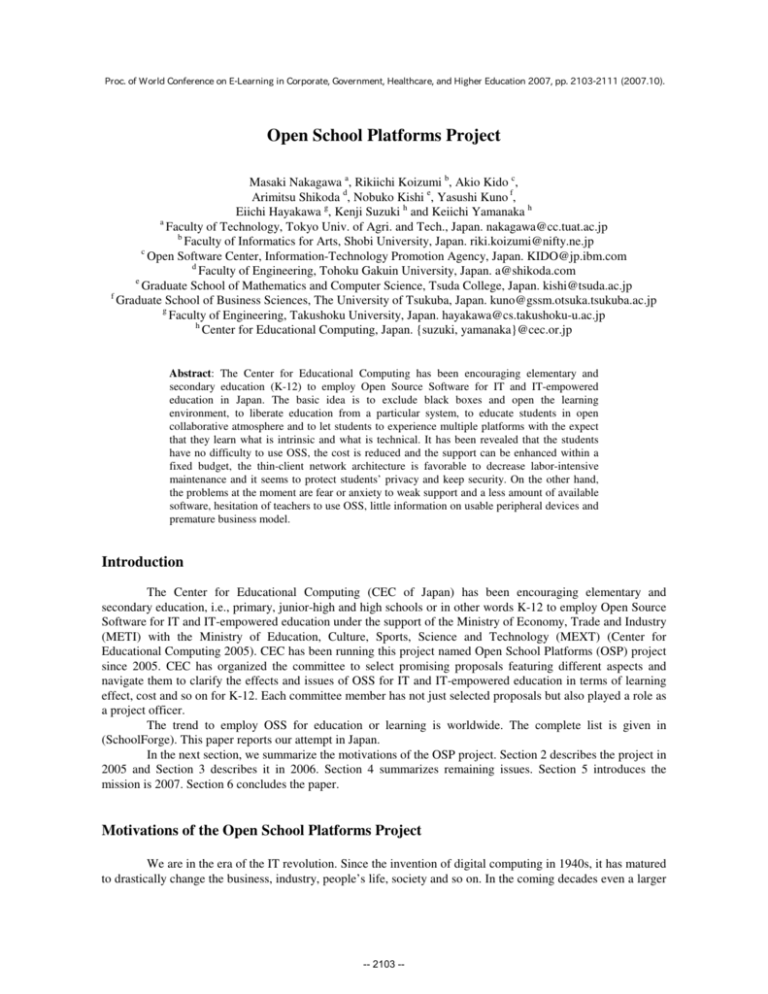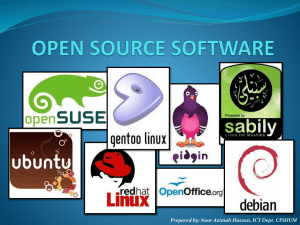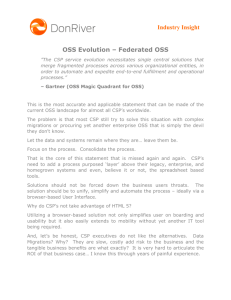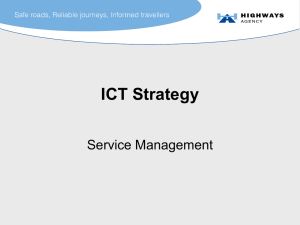eLearn 2007
advertisement

Proc. of World Conference on E-Learning in Corporate, Government, Healthcare, and Higher Education 2007, pp. 2103-2111 (2007.10).
Open School Platforms Project
Masaki Nakagawa a, Rikiichi Koizumi b, Akio Kido c,
Arimitsu Shikoda d, Nobuko Kishi e, Yasushi Kuno f,
Eiichi Hayakawa g, Kenji Suzuki h and Keiichi Yamanaka h
a
Faculty of Technology, Tokyo Univ. of Agri. and Tech., Japan. nakagawa@cc.tuat.ac.jp
b
Faculty of Informatics for Arts, Shobi University, Japan. riki.koizumi@nifty.ne.jp
c
Open Software Center, Information-Technology Promotion Agency, Japan. KIDO@jp.ibm.com
d
Faculty of Engineering, Tohoku Gakuin University, Japan. a@shikoda.com
e
Graduate School of Mathematics and Computer Science, Tsuda College, Japan. kishi@tsuda.ac.jp
f
Graduate School of Business Sciences, The University of Tsukuba, Japan. kuno@gssm.otsuka.tsukuba.ac.jp
g
Faculty of Engineering, Takushoku University, Japan. hayakawa@cs.takushoku-u.ac.jp
h
Center for Educational Computing, Japan. {suzuki, yamanaka}@cec.or.jp
Abstract: The Center for Educational Computing has been encouraging elementary and
secondary education (K-12) to employ Open Source Software for IT and IT-empowered
education in Japan. The basic idea is to exclude black boxes and open the learning
environment, to liberate education from a particular system, to educate students in open
collaborative atmosphere and to let students to experience multiple platforms with the expect
that they learn what is intrinsic and what is technical. It has been revealed that the students
have no difficulty to use OSS, the cost is reduced and the support can be enhanced within a
fixed budget, the thin-client network architecture is favorable to decrease labor-intensive
maintenance and it seems to protect students’ privacy and keep security. On the other hand,
the problems at the moment are fear or anxiety to weak support and a less amount of available
software, hesitation of teachers to use OSS, little information on usable peripheral devices and
premature business model.
Introduction
The Center for Educational Computing (CEC of Japan) has been encouraging elementary and
secondary education, i.e., primary, junior-high and high schools or in other words K-12 to employ Open Source
Software for IT and IT-empowered education under the support of the Ministry of Economy, Trade and Industry
(METI) with the Ministry of Education, Culture, Sports, Science and Technology (MEXT) (Center for
Educational Computing 2005). CEC has been running this project named Open School Platforms (OSP) project
since 2005. CEC has organized the committee to select promising proposals featuring different aspects and
navigate them to clarify the effects and issues of OSS for IT and IT-empowered education in terms of learning
effect, cost and so on for K-12. Each committee member has not just selected proposals but also played a role as
a project officer.
The trend to employ OSS for education or learning is worldwide. The complete list is given in
(SchoolForge). This paper reports our attempt in Japan.
In the next section, we summarize the motivations of the OSP project. Section 2 describes the project in
2005 and Section 3 describes it in 2006. Section 4 summarizes remaining issues. Section 5 introduces the
mission is 2007. Section 6 concludes the paper.
Motivations of the Open School Platforms Project
We are in the era of the IT revolution. Since the invention of digital computing in 1940s, it has matured
to drastically change the business, industry, people’s life, society and so on. In the coming decades even a larger
-- 2103 --
scale of impact is expected in the world economy and globalization (Anderson 2006, Freidman 2006).
Renovation of the society and even culture then triggers the further innovations in the IT technology, which will
make a positive feedback loop to expand the IT revolution.
In the stage of revolution, the technology will be renovated drastically, so that education must be
flexible. We must keep the proper balance between intrinsic materials and technical materials so that students
can learn everlasting principles as well as state-of-the-art methods and tools.
In order that the students learn to be able to keep up with or even lead the IT revolution, we have the
ideal of the learning environment for them:
(1) It should exclude black boxes. If the students are interested in the mechanism, they should be able to look
into the mechanism. Talented students may modify and customize the environment.
(2) It should liberate education from a particular system. Generation of technology changes, the current most
valuable generation of software loses its value and the next generation gains presence. The value shift from
operation systems and database systems to browsers, Web applications and contents is going on. If the
education is made on a particular system, or particular applications, it will be soon out of date.
(3) The education should be made in open collaborative atmosphere. The internet is forming the culture to
cooperate over time and space constraint. OSS has been made and enriched in this culture. It is important
that the students learn on the OSS platforms and learn the culture.
(4) It should employ multiple platforms. The students naturally learn what is common and what is different,
what is intrinsic and what is technical, what can be done and what cannot be done, etc. Along with OSS
platforms, the existing platforms play an important role to let the students to experience multiple platforms.
OSP dose not exclude the existing platforms.
Not just as the learning environment, OSS has the benefits for the IT platforms such as customizability,
transparency, cost benefit and performance and it is no less secure and reliable than propriety software (Wheeler
2007).
OSP in 2005
Proposals Adopted in 2005
In 2005, the proposals from regions shown in Fig. 1 were adopted. The number of participating schools,
that of students, the number of PCs made available and operating systems are shown in Fig. 1. A brief
explanation to each project follows (hereafter, we call each project as unit):
•
Tsukuba city and Gifu prefecture regions
These units were initiated by Information-Technology Promotion Agency (IPA) under METI in 2004 and
succeeded by CEC. The feasibility test of OSS as the learning environment and that of self-supporting operation
and management was the main focus. OSS was employed in almost all the subjects. At each school, more than
100 hours were spent employing OSS in a year. These regions are among the most advanced regions in IT and
IT-empowered learning in Japan. The units were managed by Argo 21 Corporation. The Tsukuba city region
was supervised by Prof. Koizumi and Y. Kuno while the Gifu prefecture region was supervised by A. Shikoda
and A. Kido.
•
Kyotanabe region
The educational committee and staffs of the city has been leading IT and IT-empowered learning. This region is
also one of distinguished regions in Japan. The feasibility study of remote support of the OSS environment and
learning in the environment from the educational committee was the main issue of study. OSS was employed for
subjects of Social Studies, Science and Projects as well as circle activities. At each school, more than 100 hours
were spent employing OSS in a year. The unit was managed by Uchida Yoko Co. Ltd. and supervised by R.
Koizumi and Y. Kuno.
-- 2104 --
•
Soja region
This region has a unique community of accumulating tens of thousands of digital contents for learning. The
focus of the feasibility study here is to examine how much the digital contents are usable without problems from
OSS platforms and how the thin-client network architecture is useful or suitable for schools. OSS was employed
in almost all the subjects. At each school, more than 100 hours were spent employing OSS in a year. The unit
was managed by Fujitsu Okayama Systems Engineering Ltd. and supervised by A. Shikoda and A. Kido.
Figure 1: Units in 2005.
Lessons Learnt
Neither IT education nor IT-empowered education is adequate at the moment, so that it seemed too
early to seek for the ideal of OSP. Before we started the OSP project, we had not been confident on whether we
could clarify benefits and issues of OSS platforms. This was just a fear, however, and the students who
participated had no difficulty to use OSS platforms. The system download for thin-clients is convenient and ease
the maintenance. The cost for preparing and maintaining propriety software can be redirected to enhanced
support within a fixed budget so that the teachers can more concentrate on teaching. As for students, OSS
stimulates them to try programming in club activities at junior-high schools. An additional remark to each unit
follows:
•
Tsukuba city and Gifu prefecture regions
A class room PC management system developed as OSS in the preceding IPA project in 2004 before the OSP
project, which automatically initializes or updates all the PCs in a class room, has reduced the labor-intensive
maintenance to within 5 hours a week.
•
Kyotanabe region
For all the schools, two IT coordinators helped teachers plan class work and two network engineers prepared
and maintained OSS platforms. Centralized control and management from the educational committee was
proved as a way to promote IT into education. The unit revealed several technical problems to solve.
-- 2105 --
•
Soja region
The unit employed pure thin-client network architecture. It decreased maintenance but revealed the requirement
for high performance network equipments. An IT coordinator was assigned to each school. The unit revealed
several technical problems to solve and identified the types of contents that are unplayable on OSS platforms.
Issues for 2005
Issues revealed are not true issues, since the OSP project is aimed to identify them to overcome.
Following are the issues revealed:
(1) Contents and applications are not so affluent on OSS platforms as those on propriety systems.
(2) Latest peripheral devices controllable from propriety systems may not be controllable from OSS platforms.
Even if controllable, some devices may require a strange sequence of commands for set-up.
(3) OSS is promising in IT-advanced regions where more than the critical mass of teachers are working but
how is it in ordinary regions? Some teachers are reluctant to use OSS platforms. How can we motivate
them and help them employ OSS?
(4) The thin-client architecture is promising, but how much of the downloading time can be reduced? How
secure is it?
(5) Is it possible to make the win-win business model for both schools and vendors?
OSP in 2006
Focus for 2006
Based on the experiments in 2005, we set up the following sub-goals to pursue in order to overcome
the above summarized issues.
(1) Community network
Community network to exchange ideas, share questions and answers will be helpful. Even if contents and
applications may be far fewer than propriety systems and peripheral devices may be restricted, their affluence
may not be necessary for education. If truly useful contents, applications and information are shared by the OSP
supporters, this helps teachers design learning. Moreover, someone makes contents and applications for OSS
platforms and upload them to the community to avail them. Web contents and applications can be used on
propriety systems as well.
(2) Standard package
It would be hard for ordinary teachers and schools to obtain OSS software, knowledge for installation and best
practices scattered in the internet. So, a standard package composed of OSS systems configuration, manuals,
contents, training manuals of teachers, teaching plans for students, videos, etc. would be useful for their trial use.
The materials made in 2005 should be examined and tested in ordinary schools not jut in IT-advanced schools.
(3) Software for class or school management for OSS platforms
For teachers who are not positive to use OSS platforms, it is necessary to explain the ideal of the OSP project
and to provide them with a couple of useful tools for class or school management. Teachers are the best
professionals to evangelize, once they understand the benefit and ideal of OSS.
(4) Speedup of downloading to thin-clients and evaluation of the thin-client architecture
As for the thin-client architecture, it will be necessary to shorten the downloading time for thin-client PCs and
verify the privacy-protection and security merit.
(5) Business model
We need to find business models good for both schools and vendors for continuous support.
-- 2106 --
Proposals Adopted in 2006
In 2006, we adopted the proposals from regions shown in Fig. 2. The number of participating schools,
that of students, the number of PCs involved and operating systems are shown in the figure. A brief explanation
to each unit follows:
Figure 2: Units in 2006.
•
Sendai city region (Sendai region in short)
This unit employed OSS for the subject “Information Study” at two high schools. Information Study was
introduced 4 years ago into the standard required curriculum for high schools under the direction of MEXT. The
unit employed KNOPPIX booted from a Compact Flash (CF) memory, enhanced community network formation
through a portal site and made a package. The unit was managed by Fujitsu Tohoku Systems Ltd. and supervised
by R. Koizumi and E. Hayakawa.
•
Kamisu, Kasumigaura, Tsukubamirai cities region (Tsukuba satellite region in short)
This unit attempted OSP in ordinary schools using experience and materials made in the Tsukuba city region in
2005. It employed the class room PC management system for recycled PCs with renewed batteries. This unit
also benefited from collaboration with university labs in using software made by them. It tested three support
models, namely (a) corporate support model, (b) coordinator support model and (c) self-support model. The unit
was managed by Addo Business Consultant Co. Ltd. and supervised by N. Kishi and Y. Kuno.
•
Kashiwa city region (Kashiwa region in short)
This unit employed OSS platforms for Information Study at a high school and for data analysis and presentation
at another high school. The latter school allowed students to bring them back to home and use them. The unit
also employed an OSS contents management system named Netcommons developed and supported by National
Institute of Informatics. The unit was managed by Uchida Yoko Co. Ltd. and supervised by N. Kishi and R.
Koizumi.
•
Kyotanabe city region (Kyotanabe region in short)
This unit employed Turbolinux FUJI booted form a USB flash memory, the class room PC management system
-- 2107 --
for recycled PCs with enlarged memory, and introduced school management software for schedule management,
a bulletin board and so on. It employed OSS for the subjects of Social Studies, Language, Science, Mathematics
and Projects. The unit was managed by Uchida Yoko Co. Ltd. and supervised by Y. Kuno and E. Hayakawa.
•
Soja city and Kurashiki city region (Soja region in short)
This unit aimed to prove the merit of the thin-client architecture, speed up the download time from a server to
thin-clients, prepare class or school management software suitable for the architecture. It employed OSS for the
subjects of Science and Social Studies at primary schools and for Technology at a Junior-high school. It also
employed OSS groupware for teachers to share information. Moreover, this unit studied practical employment of
IT assistants who provided teachers with technical support to prepare educational materials and students with
operational support to use PCs in a class room. The unit was managed by Fujitsu Okayama Systems Engineering
Ltd. and supervised by A. Shikoda and A. Kido.
•
Oita city and Bungoono city region (Oita region in short)
This unit applied OSS platforms for students to learn programming and make software exercises, projects and so
on at an IT-centered high school. It also employed OSS for exercises, projects and so on at an
engineering-centered high school and for business applications at a business oriented high school. It employed
KNOPPIX booted from a CD-ROM, collaborated to support network community through a portal site and made
a package. It also made a feasibility study of the business model, which is less costly but provides better support.
The unit was managed by Alpha Systems Inc. and supervised by A. Shikoda and E. Hayakawa.
Lessons Learnt
This year, we added units targeting high schools where the subject Information Study was introduced
recently. The general applicability of OSS platforms has no difference to high schools form primary schools and
junior-high schools. Scenes of learning on OSP are shown in Fig. 3.
Figure 3: Scenes of learning on OSP.
-- 2108 --
An additional remark to each unit follows:
•
Sendai region
Not just common ICT literacy lessons in Information Study, this unit let students to make an embedded program
to control LED illumination and another to control a mini airship model on the OSS platforms.
•
Tsukuba satellite region
A package prepared in IT-advanced school in Tsukuba is effective for “ordinary” regions. As for the three
support models, each model worked as expected. This suggests that each OSP site can choose the support model
suitable to its context. Among them, the coordinator support model is practical in the sense that front service is
made quickly and technically complex problems are solved by backyard engineers.
•
Kashiwa region
Among the students who were allowed to bring back PCs, more than a half did so to work at home. Among 10
students who wanted to connect their PCs to the internet at home, however, only three students succeeded.
Proper support is needed. Netcommons, i.e., OSS groupware was proved useful.
•
Kyotanabe region
The system boot was optimized to be made in 1.5 minutes. This method enabled participants to uses PCs of
others like their own. Some teachers felt booting OSS cumbersome. School management software for schedule
management, a bulletin board and so on was proved useful.
•
Soja region
The system boot for thin-clients from the server was speeded up from 5 to 2 minutes. Usability of OSS platforms
for younger students in elementary schools were significantly improved by slight customization of OSS desktop
and office suites, such as the size of icons, message texts and their font size. The introduced OSS groupware was
proved effective for school affairs and information sharing among teachers.
•
Oita region
KNOPPIX booted from a CD-ROM seems effective for students to experience multiple platforms without
reinstalling systems. This unit has made substantial learning contents for IT-centered, engineering-centered and
business oriented high schools. The business model tested here is the combination of the remote service by the
core company with on-site maintenance by local companies and it seems effective.
Achievement of Sub-goals
Here, we verify how far we have achieved the sub-goals set up in Section 3.1.
(1) Community network
Sendai region, Soja region and Oita region employed KNOPPIX, collaborated to solve technical problems,
share effective solutions and uploaded useful information to the KNOPPIX-based Education Study Group
(http://www.knoppix-edu.org/).
(2) Standard package
Each unit has prepared a standard package to be used for ordinary schools. Newcomers can select them
according to their needs and situations.
(3) Software for class or school management for OSS platforms
A couple of class or school management tools for OSS platforms were made available in OSS. They are proved
useful. Some of them are Web-based systems independent form OS. They are expected for teachers to feel the
usefulness and importance of OSS, accustomed to OSS and employ OSS for teaching with confidence.
(4) Speedup of loading systems to thin-clients and evaluation of the thin-client architecture
Loading time of systems to thin-client has been optimized. The period of 1 to 2 minutes seems not so serious
even for lessons of 50 minutes. Thin-clients enabled people to uses any PC like their own in class, teachers’
office or wherever it is without having to be conscious to the privacy or security. Although the merit was
conceived by the participants, it was but not verified clearly.
(5) Business model
Initial cost and update cost are reduced. Thus, the support can be enhanced within a fixed budget. The
combination of the remote technical service by the core company with on-site maintenance by local companies
-- 2109 --
seems effective.
Remaining issues
Although we have achieved the sub-goals to a large extent, still a majority number of schools and
teachers have fear or anxiety to weak support and a less amount of available software on OSS platforms. They
hesitate to use OSS platforms. We need to keep the effort to expand the community network and help schools or
teachers employ OSS platforms. We also need to persuade local governments to keep the budget so that schools
or teachers who employ OSS can redirect the budget saved for better support. Consequently, the teachers can
concentrate on teaching, which is most important for children. The cost shift from hardware and propriety
software to service is also important for vendors to establish the business model. If local companies can join this
market, it is good for local governments as well and stimulates young people seeking jobs there to learn OSS.
OSP for 2007
The mission of this year is to provide the OSS packages so far developed and extend or refine them in
the real use in schools. We invited vendors and schools to join this project and selected 5 vendors and 34
schools. Figure 4 shows all the schools selected.
Public: 22 schools
Private: 12 schools
Hirosaki Gakuin Seiai Junior & Senior High School
The First High school Attached to Hachinohe Institute of Technology
Yamagata Prefectural Sagae Technical Senior High School
Tohoku Gakuin Tsutsujigaoka High School
Ishikawa Prefectural Kanazawa Izumigaoka Senior High School
Tohoku Gakuin High School
Kameyama Municipal kameyama junior high school
Fukushima Prefectural Fukushima High School
Kameyama Municipal chubu junior high school
Fukushima Prefectural School for the Blind
Suma Gakuen
Saitama Prefectural Kumagaya High School
Okayama Prefectural Mizushima Technical High School
Tokyo Technical High School Attached To Nippon Institute of Technology
Kurashiki Municipal Toyosu Elementary School
Taki Senior & Junior High School
Soja Municipal Showa Elementary School
Kyoto Gakuen Junior and Senior High School
Hiroshima Municipal Asakita Senior High School
Nara Prefectural NaraSuzaku High School
Fukutsu Municipal Fukuma-higashi Junior High School
Tezukayama Gakuin Izumigaoka Junior&Senior High School
Nagasaki Prefectural Hasami High School
Osaka Prefectural Shimizudani High School
Tokai University Fuzoku Gyosei Junior and Senior High School
Miyazaki Daiichi Junior & Senior High School
Ehime Prefectural Doi Senior High School
Nippon Bunri Univ. High School
Ooita Prefectural Tsurusaki Technical High School
Ooita Prefectural Information Science School
Ooita Prefectural Miesogo High School
Ooita Prefectural Oita Commercial High School
Ooita Prefectural Tsukumi High-School
Ooita Prefectural Hita-Rinkou High School
Figure 4. Schools selected for 2007.
-- 2110 --
Conclusion
The Center for Educational Computing has been conducting the Open School Platforms (OSP) project
to employ Open Source Software for IT and IT-empowered education of K-12. The intermediate result shows
that the participating students have no difficulty to use OSS platforms. The thin-client architecture is effective
for systems maintenance and promising for keeping privacy and security. The system download time to
thin-clients has been reduced. The cost for preparing and maintaining propriety software can be redirected to
enhanced support within a fixed budget so that the teachers can more concentrate on teaching. On the other hand,
the problems at the moment are fear or anxiety to weak support and a less amount of available software,
hesitation of teachers to use OSS and premature business model.
References
Center for Educational Computing (2005). http://www.cec.or.jp/e-cec/english-e2e.html
SchoolForge. http://www.schoolforge.net/
Friedman, T.L. (2006). The World Is Flat: A Brief History of the Twenty-first Century, (Expanded and updated), Farrar
Straus & Giroux, New York.
Anderson, C. (2006). The Long Tail: Why the Future of Business is Selling Less of More, Hyperion Books, New York.
Wheeler, D.A. (2007). Why Open Source Software / Free Software (OSS/FS, FLOSS, or FOSS)? Look at the Numbers!,
http://www.dwheeler.com/contactme.html (Last revised as of April 16, 2007).
Acknowledgments
We thank the students, teachers and people who have participated in each unit, the members of the committee and officers
of CEC and METI who have been engaged in the OSP project. We would also thank Mr. Jun Iio and Mr. Kazuo Hiyane of
MRI Inc. who have been managing this project. Thanks is also due to Mr. Hutoshi Munakata of Fujitsu Tohoku Systems
Ltd., Mr. Tomohiro Isoyama of Fujitsu Okayama Systems Engineering Ltd. and Mr. Daisaku Chiba of Alpha Systems Inc.
who gave comments on this paper.
-- 2111 --





